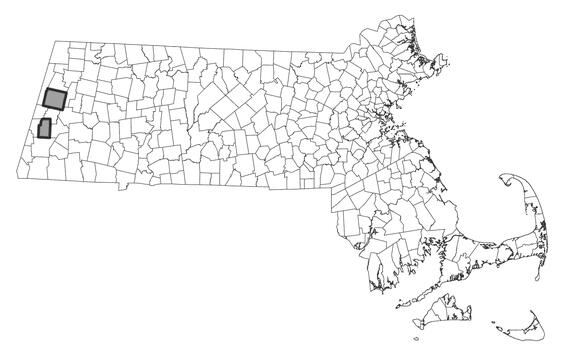- Scientific name: Eleocharis quinqueflora
- Species of Greatest Conservation Need (MA State Wildlife Action Plan)
- Endangered (MA Endangered Species Act)
Description
Few-flowered spike-sedge (Eleocharis quinqueflora) is a clustered, slender-stemmed perennial herb of wet calcareous soils. Although few-flowered spike-sedge and the other spike-sedges (also called commonly called spike-rushes) superficially resemble the group of plants called “rushes,” they are actually members of the sedge family (Cyperaceae), not the rush family (Juncaceae). The spike-sedges have a single, tight cluster of inconspicuous flowers (a “spike”) at the apex of each stem. The stems of spike-sedges appear leafless, and in fact these plants do not have leaf blades (the expanded part of the leaf), only leaf sheaths (the part that surrounds the stem). Stems of few-flowered spike-sedge are erect, 5-35 cm (2-14 in) tall, and are usually well under 1 mm (0.04 in) thick.
To positively identify few-flowered spike-sedge and other spike-sedges (genus Eleocharis), a technical manual should be consulted. It is usually necessary to look at the tiny fruits of the plant under magnification to distinguish the species of spike-sedge. Members of this genus possess a type of fruit called an “achene,” which is hard and nut-like. Achenes in the spike-sedges are topped by a protuberance (a “tubercle”), which varies in shape, size, and texture among species. Few-flowered spike-sedge differs from nearly all other spike-sedges in that the tubercle is confluent with the achene, rather than forming a distinct cap. The species gets its name from the small number of flowers per spike, typically three to nine, but many other spike-sedges are similar in this respect. Its egg-shaped spikes are 4-8 mm (0.16-0.31 in) long.
Although many spike-sedges look superficially similar to few-flowered spike-sedge, only two other species in Massachusetts have similarly confluent tubercles on the achenes. Saltpond spike-sedge (Eleocharis parvula) is a smaller plant, usually under 10 cm (4 in) tall, and the scales subtending the flowers are 1.5-2 mm (0.06-0.08 in) long, as opposed to 2.5-6 mm (0.1-0.24 in) in few-flowered spike-sedge.
Saltmarsh spike-sedge (E. rostellata) is larger, with stems usually over 40 cm (16 in), up to 1 m (3.3 ft) or more. Its spikes usually have ten to twenty or more flowers, whereas few-flowered spike-sedge spikes have fewer than ten. Also, as their common names suggest, the saltpond and saltmarsh spike-sedges occur near the coast in eastern Massachusetts, whereas few-flowered spike-sedge is found in the limestone region of the Berkshires.
Life cycle and behavior
This is a perennial sedge.
Population status
Few-flowered spike-sedge is listed under the Massachusetts Endangered Species Act as endangered. All listed species are protected from killing, collecting, possessing, or sale and from activities that would destroy habitat and thus directly or indirectly cause mortality or disrupt critical behaviors. The MassWildlife’s Natural Heritage & Endangered Species Program has 2 records from Berkshire County. Both records have been observed within the last 25 years.

Distribution in Massachusetts. 1999-2024. Based on records in the Natural Heritage Database.
Distribution and abundance
Few-flowered spike-sedge occurs across North America from Alaska to Greenland. In the western U.S. it is found as far south as Arizona and New Mexico, but east of the Rockies its southern range limit runs from Nebraska to New Jersey. It also occurs in Eurasia.
Habitat
One of the sites in Massachusetts consists of a calcareous sloping fen and a nearby calcareous basin fen, with species characteristic of these natural communities such as shrubby cinquefoil (Dasiphora floribunda), fen goldenrod (Solidago uliginosa), Kalm’s lobelia (Lobelia kalmii), knotted rush (Juncus nodosus), water sedge (Carex aquatilis), twig sedge (Cladium mariscoides), and pitcher-plant (Sarracenia purpurea). Another site is described as a shelf in disturbed mixed woods, but it includes plants typical of calcareous wetlands such as tamarack (Larix laricina), shrubby cinquefoil, yellow sedge (Carex flava), and small yellow sedge (Carex cryptolepis).
Healthy habitats are vital for supporting native wildlife and plants. Explore habitats and learn about conservation and restoration in Massachusetts.
Threats
Competition and shading by exotic and aggressive native plants may pose a threat to the habitat quality of few-flowered spike-sedge at some locations. If mowing, thinning, or invasive plant management is deemed necessary, a plan for control should be constructed and implemented. All active management of state-listed plant populations (including invasive species removal) is subject to review under the Massachusetts Endangered Species Act and should be planned in close consultation with MassWildlife’s Natural Heritage & Endangered Species Program.
Contact
| Date published: | May 7, 2025 |
|---|